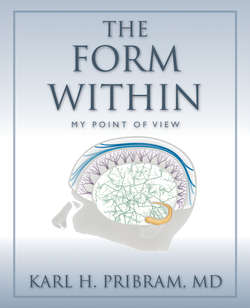Читать книгу The Form Within - Karl H Pribram - Страница 57
На сайте Литреса книга снята с продажи.
Holography
ОглавлениеLeith’s procedure was to shine a beam of coherent (laser) light through a half-silvered angled mirror that allowed some of the beam to pass straight through the mirror, and some of it to be reflected from its surface. The reflected portion of the laser light was beamed at right angles to become patterned by an object. The reflected and transmitted beams were then collected on a photographic plate, forming a spectrum made by the intersections of the two beams. Wherever these intersections occur, their amplitudes (heights) are either reinforced or diminished depending on the patterns “encoded” in the beams. A simple model of the intersections of the beams can be visualized as being very much like the intersections of two sets of circular waves made by dropping two pebbles in a pond, as described by Leonardo da Vinci.
When captured on film, the holographic process has several important characteristics that help us understand sensory processing and the reconstruction of our experience from memory. First, when we shine one of the two beams onto the holographic film, the patterns “encoded” in the other beam can be reconstructed. Thus, when one of the beams has been reflected from an object, that object can again be viewed. If both beams are reflected from objects, the image of either object can be retrieved when we illuminate the other.
An additional feature of holography is that one can retrievably store huge amounts of data on film simply by repeating the process with slight changes in the angle of the beams or the frequency of their waves (much as when one changes channels on a television set). The entire contents of the Library of Congress can be stored in 1 cubic centimeter in this manner.
Shortly after my inauguration to Emmet Leith’s demonstration of holography, I was invited to a physics meeting held in a Buddhist enclave in the San Francisco Bay area. I had noted that the only processing feature that all perceptual scientists found to be non-controversial was that the biconcave lens of the eye performed a Fourier transform on the radiant energy being processed. Jeffrey Chew, director of the Department of Physics at the University of California at Berkeley, began the conference with a tutorial on the Fourier relationship and its importance in quantum physics. He stated that any space-time pattern that we observe can be transformed into spectra that are composed of the intersections among waveforms differing in frequency, amplitude, and their relation to one another, much as Leonardo Da Vinci had observed.
My appetite for understanding the Fourier transformation was whetted and became amply rewarded.
